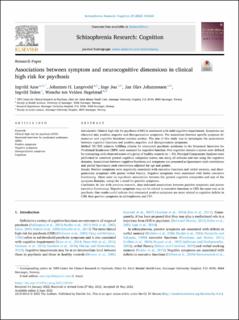| dc.contributor.author | Aase, Ingvild | |
| dc.contributor.author | Langeveld, Johannes Hendrik | |
| dc.contributor.author | Joa, Inge | |
| dc.contributor.author | Johannessen, Jan Olav | |
| dc.contributor.author | Dalen, Ingvild | |
| dc.contributor.author | Hegelstad, Wenche | |
| dc.date.accessioned | 2023-02-17T13:38:33Z | |
| dc.date.available | 2023-02-17T13:38:33Z | |
| dc.date.created | 2022-09-09T09:15:02Z | |
| dc.date.issued | 2022 | |
| dc.identifier.citation | Aase, I., Langeveld, J. H., Joa, I., Johannessen, J. O., Dalen, I., & ten Velden Hegelstad, W. (2022). Associations between symptom and neurocognitive dimensions in clinical high risk for psychosis. Schizophrenia Research: Cognition, 29, 100260. | en_US |
| dc.identifier.issn | 2215-0013 | |
| dc.identifier.uri | https://hdl.handle.net/11250/3052006 | |
| dc.description.abstract | Introduction
Clinical high risk for psychosis (CHR) is associated with mild cognitive impairments. Symptoms are clustered into positive, negative and disorganization symptoms. The association between specific symptom dimensions and cognitive functions remains unclear. The aim of this study was to investigate the associations between cognitive functions and positive, negative, and disorganization symptoms.
Method
53 CHR subjects fulfilling criteria for attenuated psychotic syndrome in the Structural Interview for Prodromal Syndromes (SIPS) were assessed for cognitive function. Five cognitive domain z-scores were defined by contrasting with observed scores of a group of healthy controls (n = 40). Principal Components Analyses were performed to construct general cognitive composite scores; one using all subtests and one using the cognitive domains. Associations between cognitive functions and symptoms are presented as Spearman's rank correlations and partial Spearman's rank correlations adjusted for age and gender.
Results
Positive symptoms were negatively associated with executive functions and verbal memory, and disorganization symptoms with poorer verbal fluency. Negative symptoms were associated with better executive functioning. There were no significant associations between the general cognitive composites and any of the symptom domains, except for a trend for positive symptoms.
Conclusion
In line with previous research, data indicated associations between positive symptoms and poorer executive functioning. Negative symptoms may not be related to executive functions in CHR the same way as in psychosis. Our results could indicate that attenuated positive symptoms are more related to cognitive deficits in CHR than positive symptoms in schizophrenia and FEP. | en_US |
| dc.language.iso | eng | en_US |
| dc.publisher | Elsevier | en_US |
| dc.rights | Navngivelse 4.0 Internasjonal | * |
| dc.rights.uri | http://creativecommons.org/licenses/by/4.0/deed.no | * |
| dc.title | Associations between symptom and neurocognitive dimensions in clinical high risk for psychosis | en_US |
| dc.title.alternative | Associations between symptom and neurocognitive dimensions in clinical high risk for psychosis | en_US |
| dc.type | Peer reviewed | en_US |
| dc.type | Journal article | en_US |
| dc.description.version | publishedVersion | en_US |
| dc.rights.holder | The authors | en_US |
| dc.subject.nsi | VDP::Medisinske Fag: 700 | en_US |
| dc.source.volume | 29 | en_US |
| dc.source.journal | Schizophrenia Research: Cognition | en_US |
| dc.identifier.doi | 10.1016/j.scog.2022.100260 | |
| dc.identifier.cristin | 2050133 | |
| cristin.ispublished | true | |
| cristin.fulltext | original | |
| cristin.qualitycode | 1 | |

